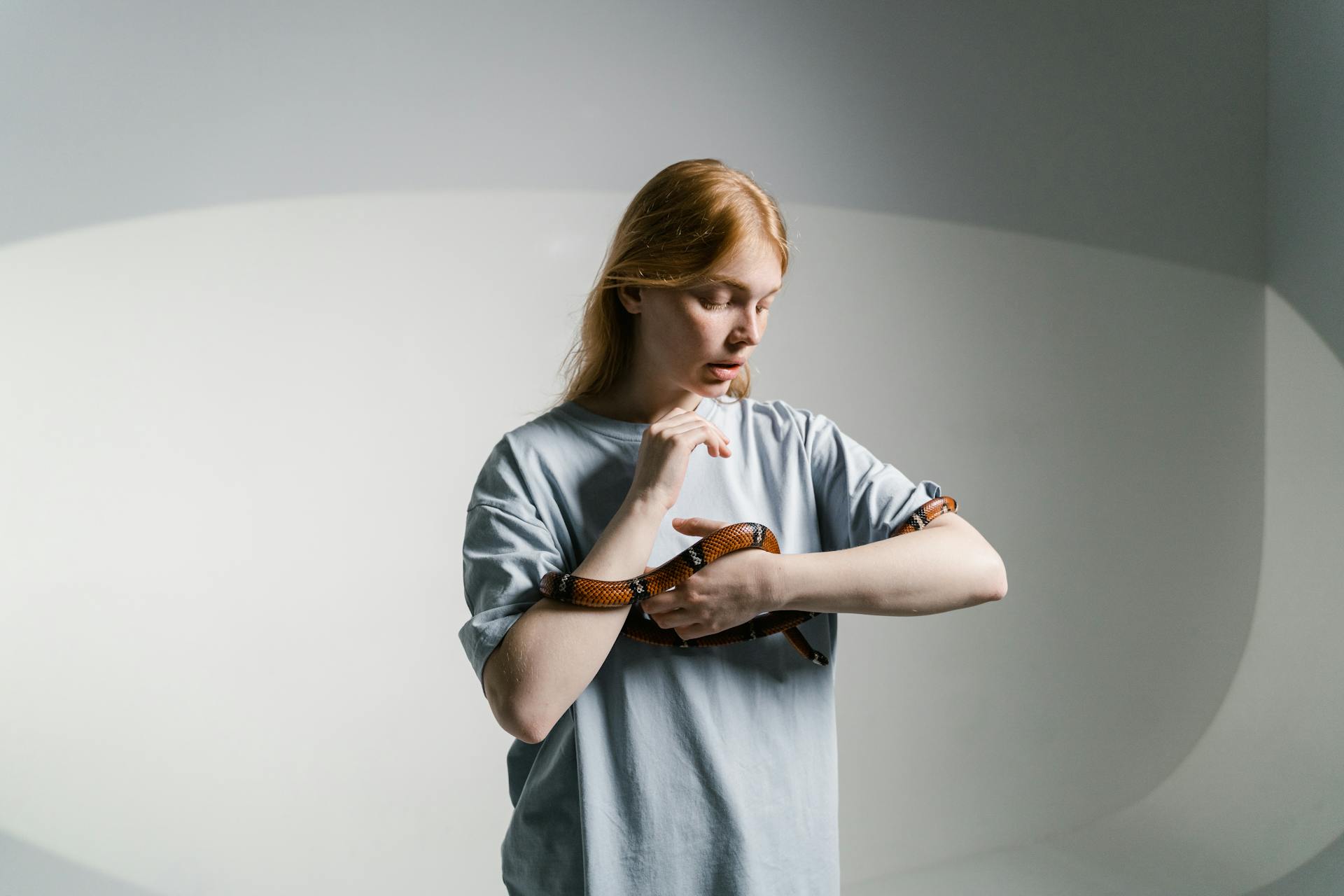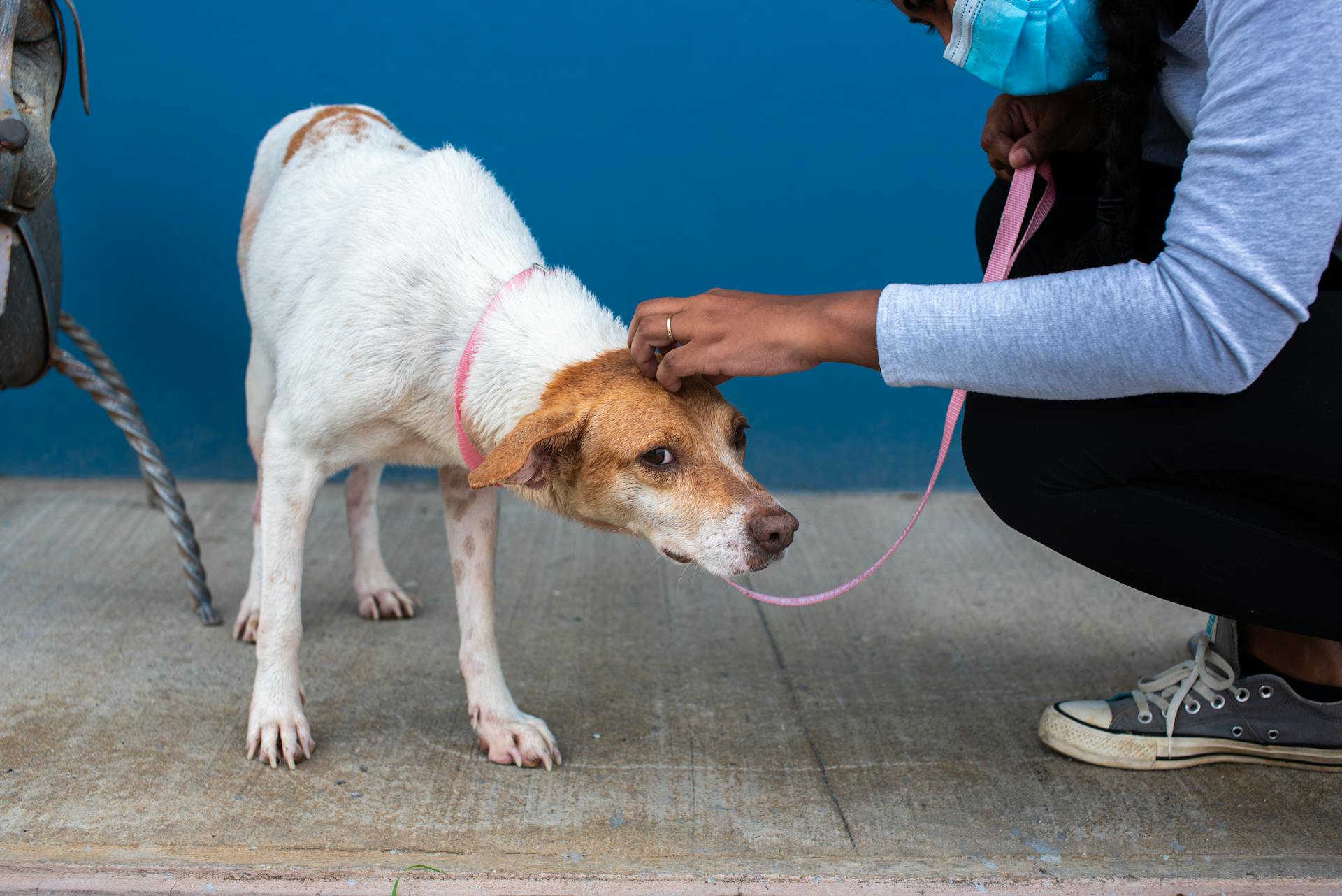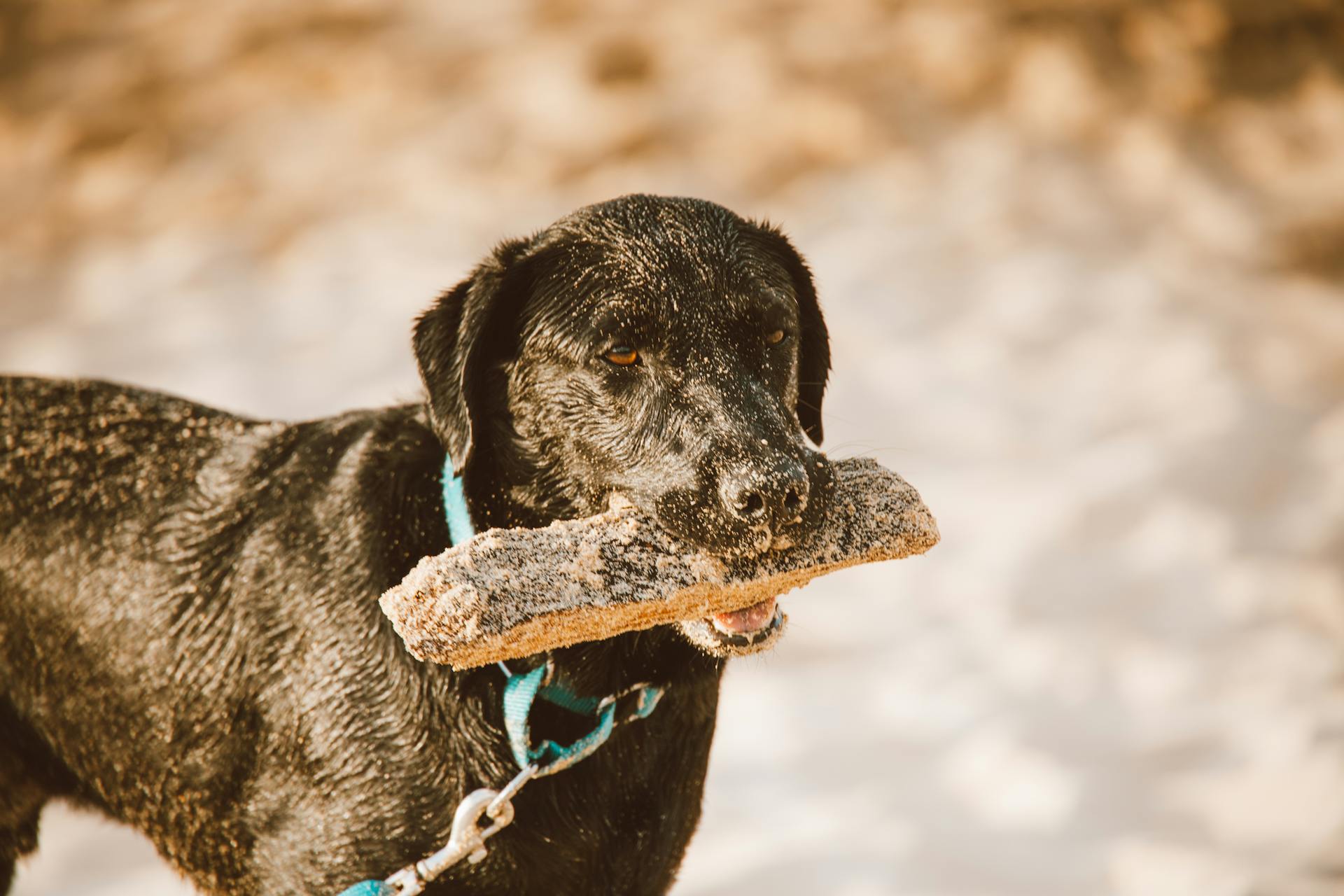
Cynophobia can be a debilitating fear, but it's not impossible to overcome. According to research, the fear of dogs can be linked to past traumatic experiences, such as being bitten or attacked by a dog.
People with cynophobia may avoid situations where they might encounter dogs, like parks or pet stores. This avoidance can lead to feelings of anxiety and isolation.
The good news is that exposure therapy can be an effective way to overcome cynophobia. This involves gradually exposing yourself to dogs in a controlled and safe environment, starting with small steps like looking at pictures or watching videos of dogs.
By facing your fears in a gradual and manageable way, you can learn to feel more comfortable around dogs.
You might like: Pronunciation of Cynophobia
What Is Cynophobia?
Cynophobia is a common phobia that affects many people. It's a fear of dogs.
Animal phobias are among the most common categories of phobias. Cynophobia is one of them.
A fear of dogs can be particularly distressing and debilitating for sufferers, especially since dogs can be found in almost any public space.
Dogs can be encountered in many places, making a fear of them hard to avoid.
Fortunately, there is a highly effective psychological therapy that works for the vast majority of children and adults suffering from cynophobia.
Causes of Dog Phobia
Most people develop a fear of dogs, known as cynophobia, due to a negative experience with a dog, especially during childhood. This can be as simple as being jumped on by an overexcited puppy or growled at by a large watchdog.
A large dog can make a major impression on a small child, even if no actual attack occurred. This can lead to a full-blown phobia of dogs.
Many parents warn children about approaching strange dogs, which can combine with a child's fertile imagination to create a fear of dogs. This can happen even if no actual attack occurred.
Some people may be more likely to develop cynophobia than others, including those with autism, generalized anxiety disorder (GAD), or a history of panic attacks or panic disorder.
A family history of phobia can also increase the risk of developing cynophobia. This can be due to learned behavior, where a child grows up with a caretaker who fears dogs.
A traumatic event, such as being bitten or chased by a dog, can also trigger cynophobia. In some cases, simply hearing or reading about someone else's traumatic experience can be enough to trigger a phobia.
Here are some common triggers for cynophobia:
- Bitten by a dog
- Chased by a dog
- Repeatedly growled at by a dog
- Infected with a disease that came from a dog, such as tapeworm
An imbalance in certain chemicals in the brain, called neurotransmitters, can also lead to anxiety disorders, including phobias. This can include an imbalance of dopamine and serotonin.
In some cases, cynophobia can be triggered by a cultural or environmental factor, such as growing up in a culture that fears dogs.
Diagnosis and Treatment
Diagnosis of cynophobia involves meeting certain criteria, including a persistent and excessive fear of dogs, an immediate anxiety response when exposed to dogs, and avoidance of dogs to the extent that it interferes with daily activities.
A mental health professional, such as a psychiatrist, will diagnose cynophobia by considering the individual's symptoms and behavior. To be diagnosed with cynophobia, one must experience excessive, unreasonable fear in the presence of dogs or when anticipating being around dogs.
The Diagnostic and Statistical Manual of Mental Disorders (DSM-5) outlines the criteria for diagnosing specific phobias, including cynophobia. According to the DSM-5, a diagnosis of cynophobia requires excessive, unreasonable fear that occurs in the presence of dogs or when anticipating being around dogs, immediate anxiety response when exposed to dogs, understanding that the fear is out of proportion to the actual threat, and avoidance of dogs that interferes with daily activities.
The most common methods for treating cynophobia are systematic desensitization and in vivo or exposure therapy. Systematic desensitization involves gradual exposure to the feared object or situation, while in vivo or exposure therapy involves direct and prolonged exposure to the feared object or situation.
Diagnosis
To receive a diagnosis of cynophobia, mental health professionals consider several key factors. These include a persistent fear of dogs, exposure to dogs triggering an immediate anxiety response, and an understanding that the fear is excessive and unreasonable.
A diagnosis of cynophobia requires that the fear significantly interferes with daily activities such as social, familial, or occupational activities. This fear must also have persisted for at least six months.
Classic avoidance behavior is common in individuals with cynophobia, including staying away from areas where dogs might be or crossing the street to avoid a dog.
The Diagnostic and Statistical Manual of Mental Disorders (DSM) outlines specific criteria for diagnosing cynophobia, including excessive and unreasonable fear triggered by the presence of dogs, immediate anxiety response, and avoidance of dogs.
Here are the key criteria for diagnosing cynophobia as outlined in the DSM:
- Excessive, unreasonable fear triggered by the presence of dogs
- Immediate anxiety response when exposed to dogs
- Understanding that the fear is out of proportion to the actual threat of being around a dog
- Avoiding dogs to the extent that it interferes with daily activities
- Fear that has persisted for at least six months
These criteria help mental health professionals accurately diagnose cynophobia and develop effective treatment plans to address the underlying anxiety and avoidance behaviors.
Diagnosis and Treatment
Diagnosis of cynophobia, or a fear of dogs, involves meeting specific criteria outlined in the DSM-5. To be diagnosed with cynophobia, you must experience excessive, unreasonable fear in the presence of dogs or when anticipating being around dogs.
Immediate anxiety response is a key symptom of cynophobia, and understanding that your fear is out of proportion to the actual threat of being around a dog is also a diagnostic criterion.
Avoiding dogs to the extent that it interferes with your daily activities is another characteristic of cynophobia. The fear must have persisted for at least six months and not be better explained by another mental health condition.
To determine if you have cynophobia, mental health professionals like psychiatrists will assess your symptoms and behavior. They will evaluate whether your fear of dogs is persistent and triggers an immediate anxiety response.
If you're diagnosed with cynophobia, there are several treatment options available. Exposure therapy, cognitive behavioral therapy (CBT), relaxation and mindfulness techniques, and medication are all effective treatments for cynophobia.

Exposure therapy involves gradual and prolonged exposure to a dog until the patient is able to experience the situation without an adverse response. This therapy can be conducted over several sessions or in a single multi-hour session.
In vivo or exposure therapy is considered the most effective treatment for cynophobia. It involves systematic and prolonged exposure to a dog until the patient is able to experience the situation without an anxiety response.
Systematic desensitization therapy, developed by Joseph Wolpe in 1958, employs relaxation techniques with imagined situations. This therapy involves visualizing a threatening situation, such as being in the same room with a dog, and then using breathing exercises and relaxation techniques to reduce anxiety.
Cognitive behavioral therapy (CBT) is a type of psychotherapy that focuses on identifying faulty thought patterns and learning how to change behaviors. For example, your therapist can help you face your irrational fear of dogs and teach you ways to cope with your anxiety disorder symptoms.
Medications such as benzodiazepines, serotonin reuptake inhibitors (SSRIs), and other types of medications can be used to treat anxiety disorders, including specific phobias like cynophobia.
Treatment Options
Systematic desensitization is a common method for treating cynophobia, developed by Joseph Wolpe in 1958. It involves imagining a threatening situation, such as being in the same room with a dog, while using relaxation techniques to reduce anxiety.
Cognitive-behavioral therapy (CBT) is also effective in treating cynophobia, particularly through techniques like active-imaginal exposure. This involves vividly imagining interacting with a dog in a positive way, such as approaching and petting it.
Exposure therapy is considered the most effective treatment for cynophobia, and can take the form of either actual exposure to dogs or virtual reality exposure. This type of therapy involves gradual and prolonged exposure to the feared stimulus until the patient can experience the situation without an adverse response.
Medications may also be used in conjunction with therapy to reduce anxiety and help the patient focus on therapeutic techniques. However, therapy is the primary treatment for cynophobia, and with the right approach, it is highly effective in reducing symptoms.
Here are some common techniques used in exposure therapy for cynophobia:
- Exposure to actual dogs: This may involve starting with talking about dogs, then progressing to looking at pictures, seeing dogs from a distance, and eventually touching a dog.
- Exposure to virtual reality (VR) dogs: This can be a useful starting point for people with severe cynophobia, as it allows them to gradually become comfortable with the idea of interacting with dogs in a safe and controlled environment.
Overall, the key to effective treatment for cynophobia is finding a approach that works for the individual, whether that's through therapy, medication, or a combination of both.
Exposure Therapy
Exposure therapy is considered the most effective treatment for cynophobia, and it involves systematic and prolonged exposure to a dog until the patient is able to experience the situation without an adverse response.
This therapy can be conducted over several sessions or in a single multi-hour session, as Lars-Göran Öst showed in a study done in 1988, where 90% of the patients were much improved or completely recovered after a mean of 2.1 hours of therapy.
In vivo or exposure therapy is considered the gold standard for treating cynophobia, and it's widely considered the most effective treatment for phobias.
Exposure therapy for cynophobia can take two forms: exposure to actual dogs and exposure to virtual reality (VR) dogs, which offers a great starting point for people with severe cynophobia.
In exposure therapy, the client is assisted by an experienced clinician to approach the object or situation that they fear while being coached on how to deal with their anxiety.
Exposure therapy was first developed as an intervention for phobias almost a hundred years ago, and there have since been numerous scientific studies demonstrating its effectiveness and refining the approach.
A meta-analysis of 33 clinical trials conducted over three decades concluded that exposure therapy was the most effective treatment for phobias, with in vivo exposure therapy being the most effective type.
Exposure therapy is so effective that one study reported a significant reduction of symptoms in over 90% of participants, which was still maintained at follow-up several years after treatment.
If you're interested in accessing exposure therapy, it's essential to find a therapist who specializes in cynophobia and has experience working with clients who have a fear of dogs.
Here are some key facts about exposure therapy:
- Exposure therapy is considered the most effective treatment for cynophobia.
- In vivo or exposure therapy is the gold standard for treating cynophobia.
- Exposure therapy can be conducted over several sessions or in a single multi-hour session.
- Exposure therapy involves systematic and prolonged exposure to a dog.
- Exposure therapy can take two forms: exposure to actual dogs and exposure to virtual reality (VR) dogs.
- Exposure therapy is widely considered the most effective treatment for phobias.
- Exposure therapy is so effective that one study reported a significant reduction of symptoms in over 90% of participants.
Note: The effectiveness of exposure therapy can vary depending on the individual and the severity of their cynophobia.
Frequently Asked Questions
What is pet phobia called?
Cynophobia is the term for a pet phobia, affecting between 7-9% of the population. Learn more about this common yet irrational fear.
What medication is used for cynophobia?
For cynophobia, medications like beta blockers may be prescribed to help manage symptoms in severe cases or situations where you'll be around dogs.
Sources
- https://en.wikipedia.org/wiki/Cynophobia
- https://www.verywellmind.com/cynophobia-fear-of-dogs-is-cynophobia-2671854
- https://www.verywellhealth.com/fear-of-dogs-cynophobia-5210624
- https://www.thecynophobiaclinic.com.au/blog/how-to-overcome-a-fear-of-dogs/
- https://www.fearof.net/fear-of-dogs-phobia-cynophobia/
Featured Images: pexels.com


